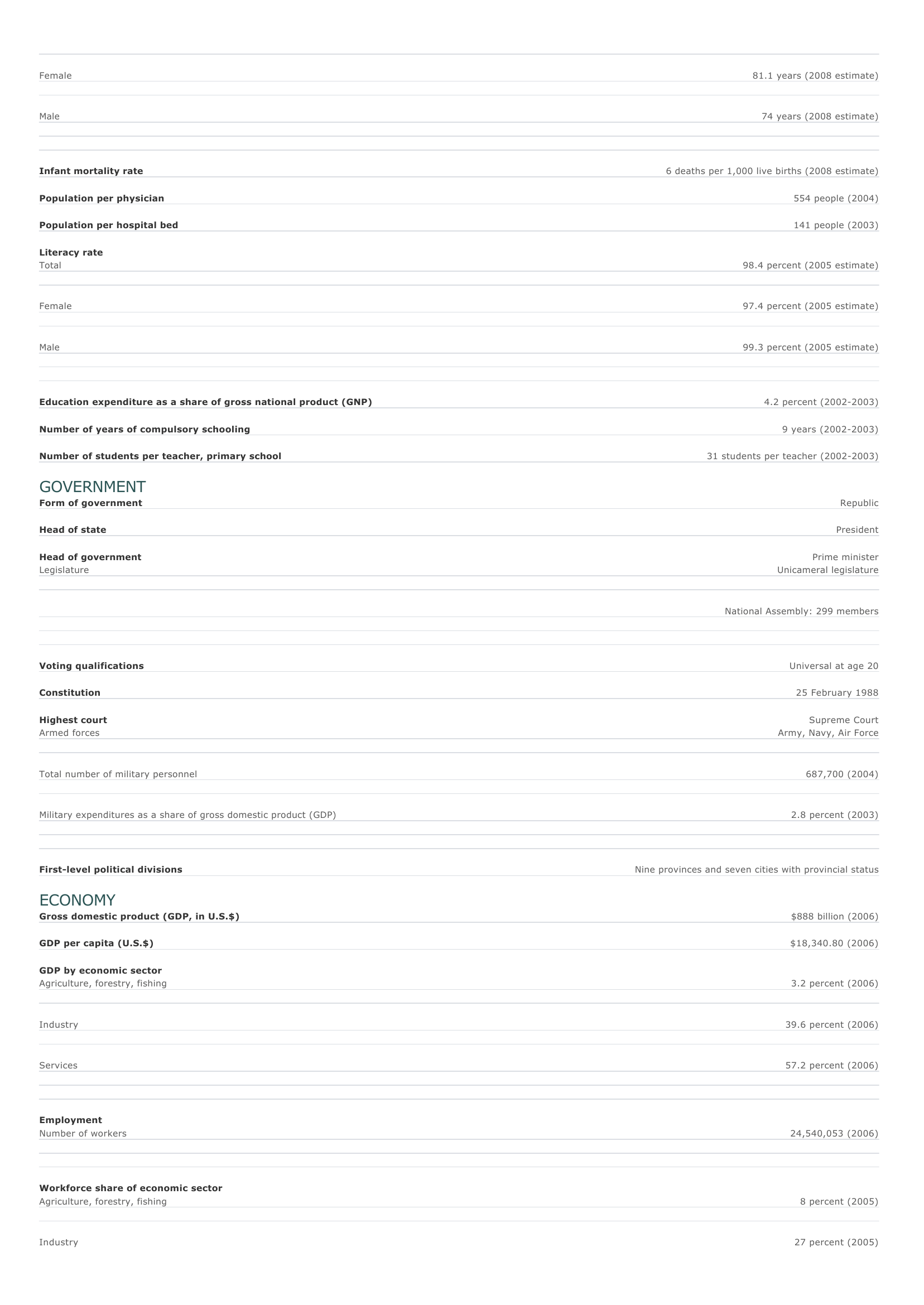South Korea Facts and Figures. BASIC FACTS Official name Capital Area Republic of Korea Seoul 99,268 sq km 38,328 sq mi PEOPLE Population 49,232,844 (2008 estimate) Population growth Population growth rate 0.37 percent (2008 estimate) Projected population in 2025 50,560,956 (2025 estimate) Projected population in 2050 45,224,224 (2050 estimate) Population density 501 persons per sq km (2008 estimate) 1,299 persons per sq mi (2008 estimate) Urban/rural distribution Share urban 81 percent (2005 estimate) Share rural 19 percent (2005 estimate) Largest cities, with population Seoul 9,714,000 (2003 estimate) B usan 3,657,840 (2005 estimate) D aegu 2,512,670 (2002 estimate) I ncheon 2,628,000 (2005 estimate) D aejeon 1,476,000 (2006 estimate) Ethnic groups Racially homogeneous Languages Korean (official), English Religious affiliations Christian 41 percent Indigenous beliefs 16 percent Buddhist 15 percent Confucianist 11 percent Nonreligious 2 percent O ther 15 percent HEALTH AND EDUCATION Life expectancy Total 77.4 years (2008 estimate) Female Male Infant mortality rate 81.1 years (2008 estimate) 74 years (2008 estimate) 6 deaths per 1,000 live births (2008 estimate) Population per physician 554 people (2004) Population per hospital bed 141 people (2003) Literacy rate Total 98.4 percent (2005 estimate) Female 97.4 percent (2005 estimate) Male 99.3 percent (2005 estimate) Education expenditure as a share of gross national product (GNP) Number of years of compulsory schooling Number of students per teacher, primary school 4.2 percent (2002-2003) 9 years (2002-2003) 31 students per teacher (2002-2003) GOVERNMENT Form of government Head of state Head of government Legislature Republic President Prime minister Unicameral legislature National Assembly: 299 members Voting qualifications Constitution Highest court Armed forces Total number of military personnel Military expenditures as a share of gross domestic product (GDP) First-level political divisions Universal at age 20 25 February 1988 Supreme Court Army, Navy, Air Force 687,700 (2004) 2.8 percent (2003) Nine provinces and seven cities with provincial status ECONOMY Gross domestic product (GDP, in U.S.$) $888 billion (2006) GDP per capita (U.S.$) $18,340.80 (2006) GDP by economic sector Agriculture, forestry, fishing 3.2 percent (2006) I ndustry 39.6 percent (2006) Services 57.2 percent (2006) Employment Number of workers Workforce share of economic sector Agriculture, forestry, fishing I ndustry 24,540,053 (2006) 8 percent (2005) 27 percent (2005) Services Unemployment rate 65 percent (2005) 3.5 percent (2004) National budget (U.S.$) Total revenue $168,390 million (2005) Total expenditure $184,130 million (2005) Monetary unit 1 South Korean won (W), consisting of 100 chon Agriculture Rice, soybeans, red peppers, barley, Chinese cabbages, watermelons, garlics; livestock Mining Coal, zinc, limestone Manufacturing Radios, televisions, video cassette recorders; transportation equipment; chemicals; machinery; food products and beverages; basic metals; textiles Major exports Electrical machinery, fabrics, road vehicles, telecommunications and sound equipment, iron and steel, metal goods, computer components, apparel Major imports Industrial machinery, petroleum and petroleum products, electrical equipment, iron and steel, transportation equipment, chemical products Major trade partners for exports United States, China, Japan, Hong Kong SAR, and Taiwan Major trade partners for imports Japan, United States, China, Saudi Arabia, and Australia ENERGY, COMMUNICATIONS, AND TRANSPORTATION Electricity production Electricity from thermal sources Electricity from hydroelectric sources Electricity from nuclear sources Electricity from geothermal, solar, and wind sources Number of radios per 1,000 people 60.51 percent (2003 estimate) 1.48 percent (2003 estimate) 37.77 percent (2003 estimate) 0.23 percent (2003 estimate) 1,039 (1997) Number of telephones per 1,000 people 492 (2005) Number of televisions per 1,000 people 364 (2000 estimate) Number of Internet hosts per 10,000 people Daily newspaper circulation per 1,000 people Number of motor vehicles per 1,000 people Paved road as a share of total roads 53 (2003) 394 (1995 estimate) 302 (2004) 87 percent (2004) SOURCES Basic Facts and People sections Area data are from the statistical bureaus of individual countries. Population, population growth rate, and population projections are from the United States Census Bureau, International Programs Center, International Data Base (IDB) (www.census.gov). Urban and rural population data are from the Food and Agriculture Organization (FAO) of the United Nations (UN), FAOSTAT database (www.fao.org). Largest cities population data and political divisions data are from the statistical bureaus of individual countries. Ethnic divisions and religion data are largely from the latest Central Intelligence Agency (CIA) World Factbook and from various country censuses and reports. Language data are largely from the Ethnologue, Languages of the World, Summer Institute of Linguistics International (www.sil.org). Health and Education section Life expectancy and infant mortality data are from the United States Census Bureau, International Programs Center, International database (IDB) (www.census.gov). Population per physician and population per hospital bed data are from the World Health Organization (WHO) (www.who.int). Education data are from the United Nations Educational, Scientific and Cultural Organization (UNESCO) database (www.unesco.org). Government section Government, independence, legislature, constitution, highest court, and voting qualifications data are largely from various government Web sites, the latest Europa World Yearbook, and the latest Central Intelligence Agency (CIA) World Factbook. The armed forces data is from Military Balance. Economy section Gross domestic product (GDP), GDP per capita, GDP by economic sectors, employment, and national budget data are from the World Bank database (www.worldbank.org). Monetary unit, agriculture, mining, manufacturing, exports, imports, and major trade partner information is from the statistical bureaus of individual countries, latest Europa World Yearbook, and various United Nations and International Monetary Fund (IMF) publications. Energy, Communication, and Transportation section Electricity information is from the Energy Information Administration (EIA) database (www.eia.doe.gov). Radio, telephone, television, and newspaper information is from the United Nations Educational, Scientific and Cultural Organization (UNESCO) database (www.unesco.org). Internet hosts, motor vehicles, and road data are from the World Bank database (www.worldbank.org). Note Figures may not total 100 percent due to rounding. Microsoft ® Encarta ® 2009. © 1993-2008 Microsoft Corporation. All rights reserved.



